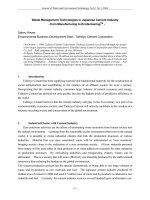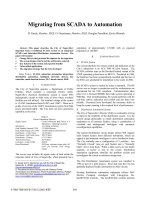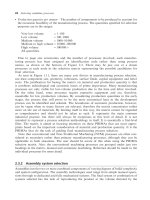Harmonic analysis from fourier to wavelets ( tql )
Bạn đang xem bản rút gọn của tài liệu. Xem và tải ngay bản đầy đủ của tài liệu tại đây (2.71 MB, 437 trang )
S T U D E N T M AT H E M AT I C A L L I B R A RY
⍀ IAS/PARK CITY MATHEMATIC AL SUBSERIES
Volume 63
Harmonic Analysis
From Fourier to Wavelets
María Cristina Pereyra
Lesley A. Ward
American Mathematical Society
Institute for Advanced Study
Harmonic Analysis
From Fourier to Wavelets
S T U D E N T M AT H E M AT I C A L L I B R A RY
IAS/PARK CITY MATHEMATIC AL SUBSERIES
Volume 63
Harmonic Analysis
From Fourier to Wavelets
María Cristina Pereyra
Lesley A. Ward
American Mathematical Society, Providence, Rhode Island
Institute for Advanced Study, Princeton, New Jersey
Editorial Board of the Student Mathematical Library
Gerald B. Folland
Robin Forman
Brad G. Osgood (Chair)
John Stillwell
Series Editor for the Park City Mathematics Institute
John Polking
2010 Mathematics Subject Classification. Primary 42–01;
Secondary 42–02, 42Axx, 42B25, 42C40.
The anteater on the dedication page is by Miguel.
The dragon at the back of the book is by Alexander.
For additional information and updates on this book, visit
www.ams.org/bookpages/stml-63
Library of Congress Cataloging-in-Publication Data
Pereyra, Mar´ıa Cristina.
Harmonic analysis : from Fourier to wavelets / Mar´ıa Cristina Pereyra, Lesley
A. Ward.
p. cm. — (Student mathematical library ; 63. IAS/Park City mathematical
subseries)
Includes bibliographical references and indexes.
ISBN 978-0-8218-7566-7 (alk. paper)
1. Harmonic analysis—Textbooks. I. Ward, Lesley A., 1963– II. Title.
QA403.P44 2012
515 .2433—dc23
2012001283
Copying and reprinting. Individual readers of this publication, and nonprofit
libraries acting for them, are permitted to make fair use of the material, such as to
copy a chapter for use in teaching or research. Permission is granted to quote brief
passages from this publication in reviews, provided the customary acknowledgment of
the source is given.
Republication, systematic copying, or multiple reproduction of any material in this
publication is permitted only under license from the American Mathematical Society.
Requests for such permission should be addressed to the Acquisitions Department,
American Mathematical Society, 201 Charles Street, Providence, Rhode Island 029042294 USA. Requests can also be made by e-mail to
c 2012 by the American Mathematical Society. All rights reserved.
The American Mathematical Society retains all rights
except those granted to the United States Government.
Printed in the United States of America.
∞ The paper used in this book is acid-free and falls within the guidelines
established to ensure permanence and durability.
Visit the AMS home page at />10 9 8 7 6 5 4 3 2 1
17 16 15 14 13 12
To Tim, Nicolás, and Miguel
To Jorge and Alexander
Contents
List of figures
xi
List of tables
xiii
IAS/Park City Mathematics Institute
Preface
xv
xvii
Suggestions for instructors
Acknowledgements
Chapter 1. Fourier series: Some motivation
xx
xxii
1
§1.1.
An example: Amanda calls her mother
2
§1.2.
The main questions
7
§1.3.
Fourier series and Fourier coefficients
10
§1.4.
History, and motivation from the physical world
15
§1.5.
Project: Other physical models
19
Chapter 2. Interlude: Analysis concepts
21
§2.1.
Nested classes of functions on bounded intervals
22
§2.2.
Modes of convergence
38
§2.3.
Interchanging limit operations
45
§2.4.
Density
49
§2.5.
Project: Monsters, Take I
52
vii
viii
Contents
Chapter 3. Pointwise convergence of Fourier series
55
§3.1.
Pointwise convergence: Why do we care?
55
§3.2.
Smoothness vs. convergence
59
§3.3.
A suite of convergence theorems
68
§3.4.
Project: The Gibbs phenomenon
73
§3.5.
Project: Monsters, Take II
74
Chapter 4. Summability methods
77
§4.1.
Partial Fourier sums and the Dirichlet kernel
78
§4.2.
Convolution
82
§4.3.
Good kernels, or approximations of the identity
90
§4.4.
Fejér kernels and Cesàro means
96
§4.5.
Poisson kernels and Abel means
99
§4.6.
Excursion into Lp (T)
101
§4.7.
Project: Weyl’s Equidistribution Theorem
102
§4.8.
Project: Averaging and summability methods
104
Chapter 5. Mean-square convergence of Fourier series
§5.1.
2
107
108
Basic Fourier theorems in L (T)
2
§5.2.
Geometry of the Hilbert space L (T)
110
§5.3.
Completeness of the trigonometric system
115
§5.4.
Equivalent conditions for completeness
122
§5.5.
Project: The isoperimetric problem
126
Chapter 6. A tour of discrete Fourier and Haar analysis
127
§6.1.
Fourier series vs. discrete Fourier basis
128
§6.2.
Short digression on dual bases in C
134
§6.3.
The Discrete Fourier Transform and its inverse
137
§6.4.
The Fast Fourier Transform (FFT)
138
§6.5.
The discrete Haar basis
146
§6.6.
The Discrete Haar Transform
151
§6.7.
The Fast Haar Transform
152
N
Contents
ix
§6.8.
Project: Two discrete Hilbert transforms
157
§6.9.
Project: Fourier analysis on finite groups
159
Chapter 7. The Fourier transform in paradise
161
§7.1.
From Fourier series to Fourier integrals
162
§7.2.
The Schwartz class
164
§7.3.
The time–frequency dictionary for S(R)
167
§7.4.
The Schwartz class and the Fourier transform
172
§7.5.
Convolution and approximations of the identity
175
§7.6.
The Fourier Inversion Formula and Plancherel
179
§7.7.
L norms on S(R)
184
§7.8.
Project: A bowl of kernels
187
p
Chapter 8. Beyond paradise
189
§8.1.
Continuous functions of moderate decrease
190
§8.2.
Tempered distributions
193
§8.3.
The time–frequency dictionary for S (R)
197
§8.4.
The delta distribution
202
§8.5.
Three applications of the Fourier transform
205
p
§8.6.
L (R) as distributions
213
§8.7.
Project: Principal value distribution 1/x
217
§8.8.
Project: Uncertainty and primes
218
Chapter 9. From Fourier to wavelets, emphasizing Haar
221
§9.1.
Strang’s symphony analogy
222
§9.2.
The windowed Fourier and Gabor bases
224
§9.3.
The wavelet transform
230
§9.4.
Haar analysis
236
§9.5.
Haar vs. Fourier
250
§9.6.
Project: Local cosine and sine bases
257
§9.7.
Project: Devil’s advocate
257
§9.8.
Project: Khinchine’s Inequality
258
x
Contents
Chapter 10. Zooming properties of wavelets
261
§10.1.
Multiresolution analyses (MRAs)
262
§10.2.
Two applications of wavelets, one case study
271
§10.3.
From MRA to wavelets: Mallat’s Theorem
278
§10.4.
How to find suitable MRAs
288
§10.5.
Projects: Twin dragon; infinite mask
298
§10.6.
Project: Linear and nonlinear approximations
299
Chapter 11. Calculating with wavelets
§11.1.
303
The Haar multiresolution analysis
303
§11.2.
The cascade algorithm
308
§11.3.
Filter banks, Fast Wavelet Transform
314
§11.4.
A wavelet library
323
§11.5.
Project: Wavelets in action
328
Chapter 12. The Hilbert transform
329
§12.1.
In the frequency domain: A Fourier multiplier
330
§12.2.
In the time domain: A singular integral
333
§12.3.
In the Haar domain: An average of Haar shifts
336
§12.4.
p
Boundedness on L of the Hilbert transform
1
341
§12.5.
Weak boundedness on L (R)
346
§12.6.
Interpolation and a festival of inequalities
352
§12.7.
Some history to conclude our journey
358
§12.8.
Project: Edge detection and spectroscopy
365
§12.9.
Projects: Harmonic analysis for researchers
366
Appendix. Useful tools
371
§A.1.
Vector spaces, norms, inner products
371
§A.2.
Banach spaces and Hilbert spaces
377
§A.3.
L (R), density, interchanging limits on R
382
p
Bibliography
391
Name index
401
Subject index
403
List of figures
1.1
A toy voice signal
3
1.2
Plot of a voice recording
6
1.3
Graph of a periodic ramp function
13
1.4
Sketch of a one-dimensional bar
17
2.1
Graph of a step function
23
2.2
Approximating a function by step functions
25
2.3
Ladder of nested classes of functions f : T → C
33
2.4
Relations between five modes of convergence
42
2.5
Pointwise but not uniform convergence
43
2
2.6
Pointwise but not mean, L , or uniform convergence
43
2.7
Convergence in mean but not pointwise
44
2.8
A continuous function approximating a step function
50
3.1
Partial Fourier sums SN f for the ramp function
57
3.2
Partial Fourier sums for the plucked string function
68
4.1
Graphs of Dirichlet kernels DN for N = 1, 3, 8
80
4.2
Dirichlet kernels DN grow logarithmically in N
81
4.3
Convolution with a kernel
93
xi
xii
List of figures
4.4
Graphs of rectangular kernels Kn for n = 2, 4, 8
94
4.5
Graphs of Fejér kernels FN for N = 1, 3, 5
97
4.6
Graphs of Poisson kernels Pr for r = 1/2, 2/3, 4/5
99
5.1
Projection of a vector onto a subspace
125
7.1
Graphs of Gauss kernels Gt for t = 1, 3, 7.5
179
9.1
A Morlet wavelet given by ψ(x) = e−t
221
9.2
The imaginary part of a Gabor function
227
9.3
The Haar wavelet h(x)
232
9.4
Daubechies wavelet function ψ, for the db2 wavelet
234
9.5
Parent interval I and its children Il and Ir
237
9.6
Graphs of two Haar functions
238
9.7
Graphs of f , P−1 f , P0 f , and Q0 f
241
9.8
Nested dyadic intervals containing a given point
244
10.1
Daubechies functions for filter lengths 4, 8, 12
267
10.2
A fingerprint and a magnified detail
276
10.3
JPEG compression and wavelet compression
277
11.1
A wavelet decomposition of a subspace
306
11.2
The Haar scaling function and the hat function
309
11.3
Three steps of a cascade with a bad filter
311
11.4
Two steps of a cascade with the Haar filter
313
11.5
A cascade where half-boxes lead to a hat
314
12.1
The Hilbert transform of a characteristic function
349
12.2
Region of integration for Fubini’s Theorem
351
12.3
The Hausdorff–Young Inequality via interpolation
354
12.4
A generalized Hölder Inequality via interpolation
354
12.5
The Hilbert transform via the Poisson kernel
360
2
/2
cos(5t)
List of tables
1.1
Physical models
20
4.1
The time–frequency dictionary for Fourier series
89
7.1
The time–frequency dictionary in S(R)
169
8.1
New tempered distributions from old
199
8.2
The time–frequency dictionary in S (R)
201
8.3
p
Effect of the Fourier transform on L spaces
215
xiii
IAS/Park City
Mathematics Institute
The IAS/Park City Mathematics Institute (PCMI) was founded in
1991 as part of the “Regional Geometry Institute” initiative of the
National Science Foundation. In mid-1993 the program found an institutional home at the Institute for Advanced Study (IAS) in Princeton, New Jersey. The PCMI continues to hold summer programs in
Park City, Utah.
The IAS/Park City Mathematics Institute encourages both research and education in mathematics and fosters interaction between
the two. The three-week summer institute offers programs for researchers and postdoctoral scholars, graduate students, undergraduate students, high school teachers, mathematics education researchers, and undergraduate faculty. One of PCMI’s main goals is to make
all of the participants aware of the total spectrum of activities that
occur in mathematics education and research: we wish to involve professional mathematicians in education and to bring modern concepts
in mathematics to the attention of educators. To that end the summer institute features general sessions designed to encourage interaction among the various groups. In-year activities at sites around the
country form an integral part of the High School Teacher Program.
xv
xvi
IAS/Park City Mathematics Institute
Each summer a different topic is chosen as the focus of the Research Program and Graduate Summer School. Activities in the Undergraduate Program deal with this topic as well. Lecture notes from
the Graduate Summer School are published each year in the IAS/Park
City Mathematics Series. Course materials from the Undergraduate
Program, such as the current volume, are now being published as
part of the IAS/Park City Mathematical Subseries in the Student
Mathematical Library. We are happy to make available more of the
excellent resources which have been developed as part of the PCMI.
John Polking, Series Editor
February 2012
Preface
Over two hundred years ago, Jean Baptiste Joseph Fourier began to
work on the theory of heat and how it flows. His book Théorie Analytique de la Chaleur (The Analytic Theory of Heat) was published
in 1822. In that work, he began the development of one of the most
influential bodies of mathematical ideas, encompassing Fourier theory
and the field now known as harmonic analysis that has grown from it.
Since that time, the subject has been exceptionally significant both in
its theoretical implications and in its enormous range of applicability
throughout mathematics, science, and engineering.
On the theoretical side, the theory of Fourier series was a driving force in the development of mathematical analysis, the study of
functions of a real variable. For instance, notions of convergence were
created in order to deal with the subtleties of Fourier series. One
could also argue that set theory, including the construction of the
real numbers and the ideas of cardinality and countability, was developed because of Fourier theory. On the applied side, all the signal
processing done today relies on Fourier theory. Everything from the
technology of mobile phones to the way images are stored and transmitted over the Internet depends on the theory of Fourier series. Most
recently the field of wavelets has arisen, uniting its roots in harmonic
analysis with theoretical and applied developments in fields such as
medical imaging and seismology.
xvii
xviii
Preface
In this book, we hope to convey the remarkable beauty and applicability of the ideas that have grown from Fourier theory. We present
for an advanced undergraduate and beginning graduate student audience the basics of harmonic analysis, from Fourier’s heat equation,
and the decomposition of functions into sums of cosines and sines
(frequency analysis), to dyadic harmonic analysis, and the decomposition of functions into a Haar basis (time localization). In between
these two different ways of decomposing functions there is a whole
world of time/frequency analysis (wavelets). We touch on aspects of
that world, concentrating on the Fourier and Haar cases.
The book is organized as follows. In the first five chapters we lay
out the classical theory of Fourier series. In Chapter 1 we introduce
Fourier series for periodic functions and discuss physical motivations.
In Chapter 2 we present a review of different modes of convergence
and appropriate classes of functions. In Chapter 3 we discuss pointwise convergence for Fourier series and the interplay with differentiability. In Chapter 4 we introduce approximations of the identity, the
Dirichlet, Fejér, and Poisson kernels, and summability methods for
Fourier series. Finally in Chapter 5 we discuss inner-product vector
spaces and the completeness of the trigonometric basis in L2 (T).
In Chapter 6, we examine discrete Fourier and Haar analysis on
finite-dimensional spaces. We present the Discrete Fourier Transform
and its celebrated cousin the Fast Fourier Transform, an algorithm
discovered by Gauss in the early 1800s and rediscovered by Cooley
and Tukey in the 1960s. We compare them with the Discrete Haar
Transform and the Fast Haar Transform algorithm.
In Chapters 7 and 8 we discuss the Fourier transform on the line.
In Chapter 7 we introduce the time–frequency dictionary, convolutions, and approximations of the identity in what we call paradise
(the Schwartz class). In Chapter 8, we go beyond paradise and discuss the Fourier transform for tempered distributions, construct a
time–frequency dictionary in that setting, and discuss the delta distribution as well as the principal value distribution. We survey the
mapping properties of the Fourier transform acting on Lp spaces, as
well as a few canonical applications of the Fourier transform including
the Shannon sampling theorem.
Preface
xix
In Chapters 9, 10, and 11 we discuss wavelet bases, with emphasis on the Haar basis. In Chapter 9, we survey the windowed Fourier
transform, the Gabor transforms, and the wavelet transform. We develop in detail the Haar basis, the geometry of dyadic intervals, and
take some initial steps into the world of dyadic harmonic analysis.
In Chapter 10, we discuss the general framework of multiresolution
analysis for constructing other wavelets. We describe some canonical applications to image processing and compression and denoising,
illustrated in a case study of the wavelet-based FBI fingerprint standard. We state and prove Mallat’s Theorem and explain how to search
for suitable multiresolution analyses. In Chapter 11, we discuss algorithms and connections to filter banks. We revisit the algorithm
for the Haar basis and the multiresolution analysis that they induce.
We describe the cascade algorithm and how to implement the wavelet
transform given multiresolution analysis, using filter banks to obtain
the Fast Wavelet Transform. We describe some properties and design features of known wavelets, as well as the basics of image/signal
denoising and compression.
To finish our journey, in Chapter 12 we present the Hilbert transform, the most important operator in harmonic analysis after the
Fourier transform. We describe the Hilbert transform in three ways:
as a Fourier multiplier, as a singular integral, and as an average of
Haar shift operators. We discuss how the Hilbert transform acts
on the function spaces Lp , as well as some tools for understanding
the Lp spaces. In particular we discuss the Riesz–Thorin Interpolation Theorem and as an application derive some of the most useful
inequalities in analysis. Finally we explain the connections of the
Hilbert transform with complex analysis and with Fourier analysis.
Each chapter ends with ideas for projects in harmonic analysis
that students can work on rather independently, using the material
in our book as a springboard. We have found that such projects help
students to become deeply engaged in the subject matter, in part by
giving them the opportunity to take ownership of a particular topic.
We believe the projects will be useful both for individual students
using our book for independent study and for students using the book
in a formal course.
xx
Preface
The prerequisites for our book are advanced calculus and linear
algebra. Some knowledge of real analysis would be helpful but is not
required. We introduce concepts from Hilbert spaces, Banach spaces,
and the theory of distributions as needed. Chapter 2 is an interlude about analysis on intervals. In the Appendix we review vector,
normed, and inner-product spaces, as well as some key concepts from
analysis on the real line.
We view the book as an introduction to serious analysis and computational harmonic analysis through the lens of Fourier and wavelet
analysis.
Examples, exercises, and figures appear throughout the text. The
notation A := B and B =: A both mean that A is defined to be the
quantity B. We use the symbol to mark the end of a proof and the
symbol ♦ to mark the end of an example, exercise, aside, remark, or
definition.
Suggestions for instructors
The first author used drafts of our book twice as the text for a onesemester course on Fourier analysis and wavelets at the University
of New Mexico, aimed at upper-level undergraduate and graduate
students. She covered most of the material in Chapters 1 and 3–11
and used a selection of the student projects, omitting Chapter 12 for
lack of time. The concepts and ideas in Chapter 2 were discussed as
the need arose while lecturing on the other chapters, and students
were encouraged to revisit that chapter as needed.
One can design other one-semester courses based on this book.
The instructor could make such a course more theoretical (following
the Lp stream, excluding Chapters 6, 10, and 11) or more computational (excluding the Lp stream and Chapter 12 and including Chapter 6 and parts of Chapters 10 and 11). In both situations Chapter 2
is a resource, not meant as lecture material. For a course exclusively
on Fourier analysis, Chapters 1–8 have more than enough material.
For an audience already familiar with Fourier series, one could start
in Chapter 6 with a brief review and then do the Discrete Fourier and
Haar Transforms, for which only linear algebra is needed, and move
on to Fourier integrals, Haar analysis, and wavelets. Finally, one
Suggestions for instructors
xxi
could treat the Hilbert transform or instead supplement the course
with more applications, perhaps inspired by the projects. We believe
that the emphasis on the Haar basis and on dyadic harmonic analysis
make the book distinctive, and we would include that material.
The twenty-four projects vary in difficulty and sophistication. We
have written them to be flexible and open-ended, and we encourage
instructors to modify them and to create their own. Some of our
projects are structured sequentially, with each part building on earlier
parts, while in other projects the individual parts are independent.
Some projects are simple in form but quite ambitious, asking students
to absorb and report on recent research papers. Our projects are
suitable for individuals or teams of students.
It works well to ask students both to give an oral presentation
on the project and to write a report and/or a literature survey. The
intended audience is another student at the same stage of studies but
without knowledge of the specific project content. In this way, students develop skills in various types of mathematical communication,
and students with differing strengths get a chance to shine. Instructors can reserve the last two or three weeks of lectures for student
talks if there are few enough students to make this practicable. We
find this to be a worthwhile use of time.
It is fruitful to set up some project milestones throughout the
course in the form of a series of target dates for such tasks as preparing
outlines of the oral presentation and of the report, drafting summaries
of the first few items in a literature survey, rehearsing a presentation,
completing a draft of a report, and so on. Early planning and communication here will save much stress later. In the second week of
classes, we like to have an initial ten-minute conversation with each
student, discussing a few preliminary sentences they have written on
their early ideas for the content and structure of the project they
plan to do. Such a meeting enables timely intervention if the proposed scope of the project is not realistic, for instance. A little later
in the semester, students will benefit from a brief discussion with the
instructor on the content of their projects and their next steps, once
they have sunk their teeth into the ideas.
xxii
Preface
Students may find it helpful to use the mathematical typesetting
package LATEX for their reports and software such as Beamer to create
slides for their oral presentations. Working on a project provides good
motivation for learning such professional tools. Here is a natural
opportunity for instructors to give formal or informal training in the
use of such tools and in mathematical writing and speaking. We
recommend Higham’s book [Hig] and the references it contains as
an excellent place to start. Instructors contemplating the task of
designing and planning semester-long student projects will find much
food for thought in Bean’s book [Bea].
Acknowledgements
Our book has grown out of the lecture course we taught at the Institute for Advanced Study IAS/Princeton Program for Women in
Mathematics on analysis and partial differential equations, May 17–
28, 2004. We thank Manuela de Castro and Stephanie Molnar (now
Salomone), our teaching assistants during the program, for their invaluable help and all the students for their enthusiasm and lively participation. We thank Sun-Yung Alice Chang and Karen Uhlenbeck
for the opportunity to participate in this remarkable program.
The book also includes material from a course on wavelets developed and taught by the second author twice at Harvey Mudd College
and again at the IAS/Park City Mathematics Institute Summer Session on harmonic analysis and partial differential equations, June 29–
July 19, 2003. We thank her teaching assistant at PCMI, Stephanie
Molnar.
Some parts of Chapters 10 and 11 are drawn from material in the
first author’s book [MP]. This material originated in lecture notes by
the first author for minicourses delivered by her (in Argentina in 2002
and in Mexico in 2006) and by Martin Mohlenkamp (in Honduras in
2004; he kindly filled in for her when her advanced pregnancy made
travel difficult).
Early drafts of the book were written while the second author was
a member of the Department of Mathematics, Harvey Mudd College,
Claremont, California.
Acknowledgements
xxiii
The mathematical typesetting software LATEX and the version
control system Subversion were invaluable, as was Barbara Beeton’s
expert assistance with LATEX. The MathWorks helped us with Matlab through its book program for authors. We created the figures
using LATEX and Matlab. Early versions of some figures were kindly
provided by Martin Mohlenkamp. We thank John Polking for his
help in improving many of the Matlab figures and John Molinder
and Jean Moraes for recording and plotting the voice signal in Figure 1.2. We gratefully acknowledge Chris Brislawn’s permission to
reproduce figures and other material from his website about the FBI
Fingerprint Image Compression Standard [Bri02].
In writing this book, we have drawn on many sources, too numerous to list in full here. An important debt is to E. M. Stein and
R. Shakarchi’s book [SS03], which we used in our Princeton lectures
as the main text for classical Fourier theory. We were particularly
inspired by T. Körner’s book [Kör].
Students who took the wavelets courses at the University of New
Mexico proofread the text, suggesting numerous improvements. We
have incorporated several of their ideas for projects. Harvey Mudd
College students Neville Khambatta and Shane Markstrum and Claremont Graduate University student Ashish Bhan typed LATEX notes
and created Matlab figures for the second author’s wavelets course.
In the final stages, Matthew Dahlgren and David Weirich, graduate
students at the University of New Mexico, did a careful and thoughtful reading, giving us detailed comments from the point of view of an
informed reader working through the book without a lecture course.
They also contributed to the subject index. Lisa Schultz, an Honours
student at the University of South Australia, completed both indexes
and helped with the final touches. Over the years colleagues and
students have given suggestions on draft versions, including Wilfredo
Urbina, University of New Mexico graduate students Adam Ringler
and Elizabeth Kappilof, and Brown University graduate student Constance Liaw. We thank Jorge Aarão for reading and commenting on
our almost-final manuscript.
We thank the following students who wrote project reports,
gave presentations, and in some cases came up with research topics:
xxiv
Preface
Kourosh Raeen (the project in Section 3.4), Adam Ringler (the project
in Section 6.9), Mike Klopfer (the project in Section 10.6), and
Bernadette Mendoza-Spencer (the project in Section 12.9.1).
Abbreviated versions of the projects in Sections 3.4, 4.8, and 9.7
were tested as guided one-day projects with fifteen to eighteen upperlevel undergraduates and first-year graduate students in three editions
of the one-week minicourse on Fourier analysis and wavelets taught
by the first author as part of the NSF-sponsored Mentoring Through
Critical Transition Points (MCTP) Summer Program held at the
University of New Mexico in July 2008, June 2009, and July 2010.
We are grateful for the helpful and constructive suggestions of
the anonymous reviewers.
Special thanks go to our editor Ed Dunne and the AMS editorial
staff, who have guided us from our brief initial draft to the completion
of this book.
The generous contributions of all these people helped us to make
this a better book, and we thank them all. All remaining errors and
infelicities are entirely our responsibility.
Finally we would like to thank our families for their patience and
love while this book has been in the making. During these years a
baby was born, one of us moved from the US to Australia, and energetic toddlers grew into thriving ten- and eleven-year-old children.
Our parents, our constant supporters and cheerleaders, now more
than ever need our support and love. This writing project is over,
but life goes on.
María Cristina Pereyra, University of New Mexico
Lesley A. Ward, University of South Australia
February 2012









